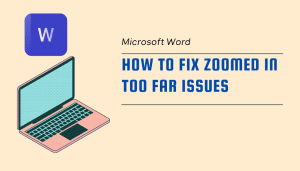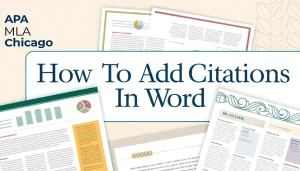Last Updated: January 23, 2025
Changing font styles in Microsoft Word elevates the visual appeal of your documents. By choosing different font types, sizes, and colors, you can effectively express your ideas. If you’re crafting a school report or a letter, the right font choice makes your words stand out.
This guide provides clear steps to modify font styles. We’ll explore into into necessary tools like bold, italics, and underline. By the end, you’ll be equipped to use Microsoft Word confidently, creating stunning documents that showcase your unique style!
Table Of Contents
Understanding Font Styles in MS Word
Mastering font styles in Microsoft Word is critical for effective text formatting. Font styles influence the appearance of your documents, impacting both readability and in general design. You can choose from different font types like Arial, Times New Roman, and Calibri, each with a unique character suited for different contexts.
To change the font size, highlight the text and select your preferred size from the font group in the Home tab. To emphasize specific words, use bold, italics, or underline. These styles can effectively highlight key points or improve a visually appealing paragraph style.
Changing the text color can also improve your message remarkably. Access font color options from the same menu. By mastering these formatting tools, you can create professional documents that stand out. Setting a default font ensures consistency, making it easier to maintain a together look across your projects.
| Font Style | Use Case |
|---|---|
| Bold | Highlighting significant text |
| Italics | Emphasizing titles or quotes |
| Underline | Drawing attention to links |
By understanding these elements, you can create visually appealing documents that effectively convey your ideas.
Types of Font Styles
In Microsoft Word, different font styles improve your documents, each serving a distinct purpose and boosting readability. Let’s explore some common types:
- Bold: Thickens text to make it stand out, perfect for headings.
- Italics: Slanted text that emphasizes words or indicates titles.
- Underline: Highlights key points effectively.
- Font Color: Changing text color conveys mood or importance.
To apply these styles, use the formatting toolbar in the Home tab. Here, you can also adjust font size and character spacing to improve your document’s design. For instance, combine bold text with a larger font size to emphasize a section.
For a together look, use a style set or templates. This ensures your documents are visually appealing and consistent. To learn more about customizing styles, check out this guide on custom styles in Word.
By mastering these font types and their applications, you can transform your documents into engaging, professional pieces. Whether for a school project or a personal letter, effective text formatting enhances communication.
Default Font Settings
To set your preferred font as the default in Word, go to the Home tab and click the Font dialog box launcher in the bottom right corner. This opens options for font size, color, and style, enhancing your document’s design and readability.
Changing the default font creates a consistent look across all your documents. If you often use bold or italics, you can set those styles too. After making your selections, click Set As Default to apply them to all new documents.
Effective text formatting in Microsoft Word is necessary for clear communication. You can easily modify paragraph styles, adjust character spacing, and change line spacing. For a deeper understanding of customizing font settings, check out this guide on changing default font.
The ribbon interface offers a range of formatting tools that simplify this process. Choose from different font families and styles to make sure your documents look polished and professional. Whether for a school project or a report, mastering these options remarkably boosts your word processing skills.
By mastering font styles and settings, you improve both the appearance and impact of your documents. A well-formatted document is more engaging and easier to read, making your communication more effective.
Using the Ribbon Interface for Font Changes
The Ribbon Interface in Microsoft Word is necessary for enhancing your documents’ visual appeal. This intuitive toolbar offers quick access to a range of text formatting tools. To modify font styles, steer to the Home tab, where you’ll find options for font size, font color, and styles such as bold, italics, and underline.
Here’s how to make your text pop:
- Changing Font Type: Select the font dropdown to explore different font families.
- Adjusting Font Size: Use the font size box to modify text size effortlessly.
- Applying Text Styles: Click B, I, or U for bold, italic, or underline effects.
- Choosing Text Color: Click the color icon to change the text color quickly.
For advanced options, access the font issues dialog box by clicking the small arrow in the bottom right corner of the font group. This reveals additional settings for character spacing and line spacing.
This versatility in document design enables you to craft professional-looking documents tailored to your audience. By mastering these tools, you’ll lift your typography skills, making your writing more engaging and impactful.
Accessing Font Options
Accessing font options in Microsoft Word is straightforward using the Ribbon Interface. Begin by clicking the Home tab, where the Font group is located. This section offers critical tools for adjusting font styles, font size, and more. For help with font issues, check out this guide.
To change the font style, click the small arrow in the bottom right corner of the Font box. This opens the Font dialog box, where you can choose different font types, adjust text color, and apply effects like bold, italics, or underline. You can also modify character spacing and line spacing to improve readability.
Increase your efficiency with keyboard shortcuts: use Ctrl + B for bold, Ctrl + I for italics, and Ctrl + U for underline. These shortcuts simplify formatting, allowing you to concentrate on your document design seamlessly.
Selecting the right font family and size is necessary for how your text is perceived. By mastering these formatting tools, you can craft visually appealing documents that effectively communicate your message.
Quick Formatting Shortcuts
Using quick formatting shortcuts in Microsoft Word saves time and improves your document’s look. For instance, make text bold with Ctrl + B, italicize it using Ctrl + I, and underline with Ctrl + U. These shortcuts allow you to highlight significant points without finding your way the ribbon interface.
Adjusting font size is easy. Increase it quickly with Ctrl + Shift + > or decrease it with Ctrl + Shift + <. To change the font color, use the shortcut keys to open the color picker, enabling customized and attractive text.
For text alignment, use Ctrl + E for center, Ctrl + L for left, and Ctrl + R for right. These shortcuts are necessary for creating a professional layout.
To access the Font dialog box for detailed adjustments, click the small arrow in the bottom right of the Font group on the Home tab. Here, you can change the font family and other attributes for a refined finish.
Advanced Text Formatting Techniques
Changing font styles in Microsoft Word is necessary for creating visually appealing documents. Lift your text formatting by adjusting font types, sizes, and colors. Follow this quick guide:
- Open MS Word: Start your document.
- Select Text: Highlight the text you want to change.
- Access Font Options: Click the small arrow in the Font section of the Home tab.
- Choose Your Style: Select your preferred font family, size, and color.
- Apply Formatting: Use options like bold, italics, or underline to highlight your text.
Improve paragraph formatting by adjusting line spacing and character spacing. This creates a clear visual hierarchy in your documents. For instance, effective use of headers and footers can greatly organize your content.
By mastering these advanced text formatting techniques, you can transform your documents into visually striking and easy-to-read works of art!
Applying Bold, Italics, and Underline
In Microsoft Word, applying bold, italics, and underline dramatically enhances the visual appeal of your text. These formatting techniques create a clear visual hierarchy in your documents. To make text bold, highlight it and click the B icon or use Ctrl + B. For italics, click the I icon or press Ctrl + I. Underlining is similarly simple—click the U icon or press Ctrl + U.
Using these styles effectively emphasizes key points, making your writing more engaging. For instance, in a report, highlighting necessary findings in bold draws attention. Plus, selecting complementary fonts can further increase readability.
Enhancing your document with text color and font size adds another layer of emphasis. The goal is to create a document that is both informative and visually striking. By mastering these text formatting techniques, you lift your document design and make sure your message resonates.
Changing Font Color and Size
Changing the font color and size in Microsoft Word is necessary for creating visually appealing documents. To change the font color, highlight the text and click the Font Color icon in the ribbon. For size adjustments, select the desired size from the Font Size dropdown menu. These customizations highlight significant information and help establish a distinctive typography style.
- Font Color: Click the “A” icon with a color underline to choose your color.
- Font Size: Select your preferred size from the dropdown next to the font name.
To make your chosen font the default, open the Font dialog box. This not only enhances your document’s design but also ensures uniformity across all your projects.
For more details on font customization, check out font styles in Word.
Summing up
Changing font styles in MS Word remarkably improves the appearance and readability of documents. By choosing different fonts, sizes, and colors, you can effectively communicate your ideas. The formatting tools allow you to create a unique style that showcases your creativity. Practice is necessary; the more you experiment with these options, the more proficient you will become. Explore these features to make your text truly stand out!
Frequently Asked Questions
What is the basic font style in MS Word?
The basic font style in MS Word is “Calibri,” usually set at 11-point size for a clean, modern look.
How do you change styles quickly in Word?
To change styles quickly in Word, use the Styles gallery on the Home tab. Just click a style to apply it instantly!
How do I change font styles in MS Word?
To change font styles in MS Word, select text, go to the Home tab, choose a font from the dropdown, and adjust size or color as needed.
Can I customize font styles in MS Word?
Yes, you can customize font styles in MS Word by modifying existing styles or creating new ones in the Font dialog box.






Pingback: OneNote Templates & Page Layouts: 10 Designs You'll Actually Use | MSW Tutor.